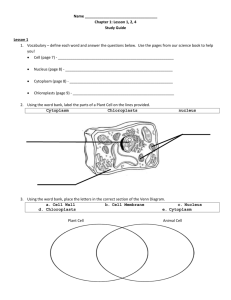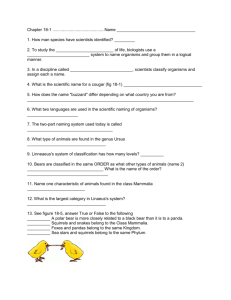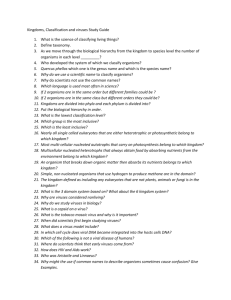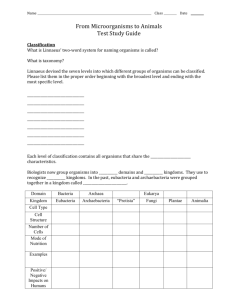Kingdom Review - Part 2
advertisement
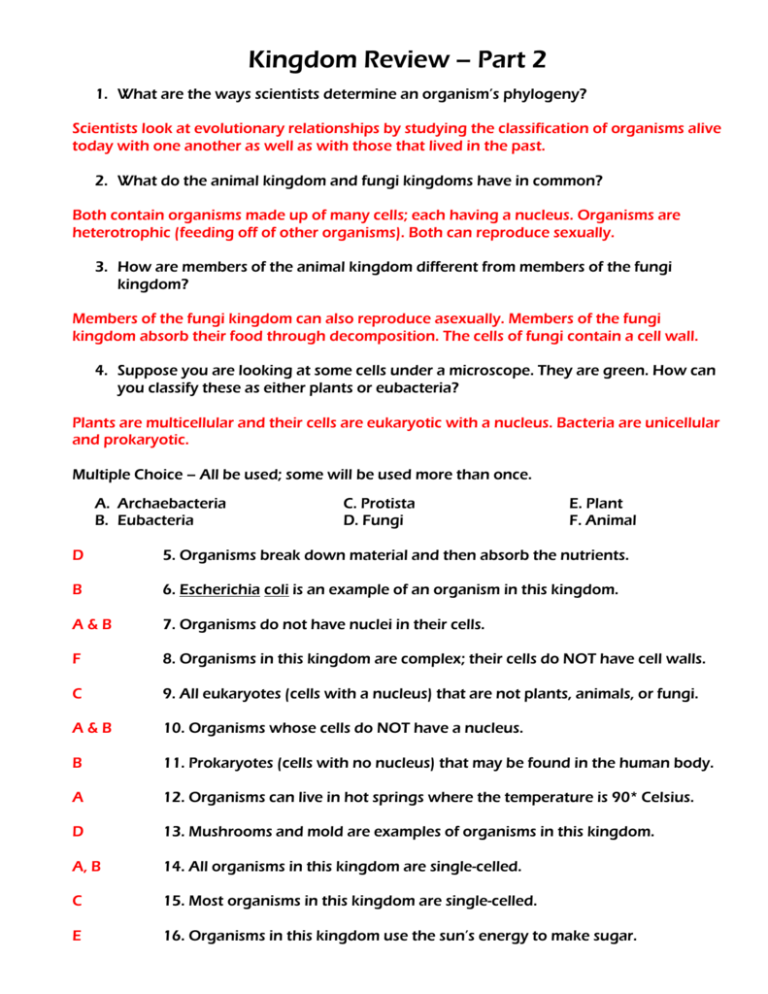
Kingdom Review – Part 2 1. What are the ways scientists determine an organism’s phylogeny? Scientists look at evolutionary relationships by studying the classification of organisms alive today with one another as well as with those that lived in the past. 2. What do the animal kingdom and fungi kingdoms have in common? Both contain organisms made up of many cells; each having a nucleus. Organisms are heterotrophic (feeding off of other organisms). Both can reproduce sexually. 3. How are members of the animal kingdom different from members of the fungi kingdom? Members of the fungi kingdom can also reproduce asexually. Members of the fungi kingdom absorb their food through decomposition. The cells of fungi contain a cell wall. 4. Suppose you are looking at some cells under a microscope. They are green. How can you classify these as either plants or eubacteria? Plants are multicellular and their cells are eukaryotic with a nucleus. Bacteria are unicellular and prokaryotic. Multiple Choice – All be used; some will be used more than once. A. Archaebacteria B. Eubacteria C. Protista D. Fungi E. Plant F. Animal D 5. Organisms break down material and then absorb the nutrients. B 6. Escherichia coli is an example of an organism in this kingdom. A&B 7. Organisms do not have nuclei in their cells. F 8. Organisms in this kingdom are complex; their cells do NOT have cell walls. C 9. All eukaryotes (cells with a nucleus) that are not plants, animals, or fungi. A&B 10. Organisms whose cells do NOT have a nucleus. B 11. Prokaryotes (cells with no nucleus) that may be found in the human body. A 12. Organisms can live in hot springs where the temperature is 90* Celsius. D 13. Mushrooms and mold are examples of organisms in this kingdom. A, B 14. All organisms in this kingdom are single-celled. C 15. Most organisms in this kingdom are single-celled. E 16. Organisms in this kingdom use the sun’s energy to make sugar. MICROSCOPE 17. The invention that helped scientists discover new classification kingdoms. TAXONOMY 18. The name of the science of classification. LATIN 19. The language of classification. KINGDOM 20. The largest group in the classification system. SPECIES 21. The smallest group in the classification system. BACTERIA (MONERA) 22. The smallest organisms are found in what kingdom? PLANT 23. All organisms in this kingdom make their own food. TRUE or FALSE? TRUE 24. Classification helps to show how organisms are related. FALSE 25. Visual traits are always reliable when classifying organisms. TRUE 26. Scientists accept new ways to classify organisms. FALSE 27. Method of reproduction is not considered a trait when classifying organisms. TRUE 28. All members of the six kingdoms are living organisms. TRUE 29. Scientific names use the genus and species levels of classification. TRUE 30. Living matter reproduces and passes on genetic material to their offspring. 31. List the 7 levels of classification from broadest to most specific. KINGDOM – PHYLUM – CLASS – ORDER – FAMILY – GENUS - SPECIES 32. List 6 traits/characteristics that could be used to classify organisms. PHYSICAL APPEARANCE BEHAVIOR DNA/GENETICS LOCOMOTION DIET METHOD OF REPRODUCTION CELLS – UNICELLULAR or MULTICELLULAR CELLS – PROKARYOTIC or EUKARYOTIC HABITAT/NICHE BODY STRUCTURE 33. How did Linnaeus contribute the classification system that scientists use today? Linnaeus coined the term “kingdom”, “genus”, and “species” and developed binomial nomenclature; giving all living things a two-part, Latin, scientific name.



